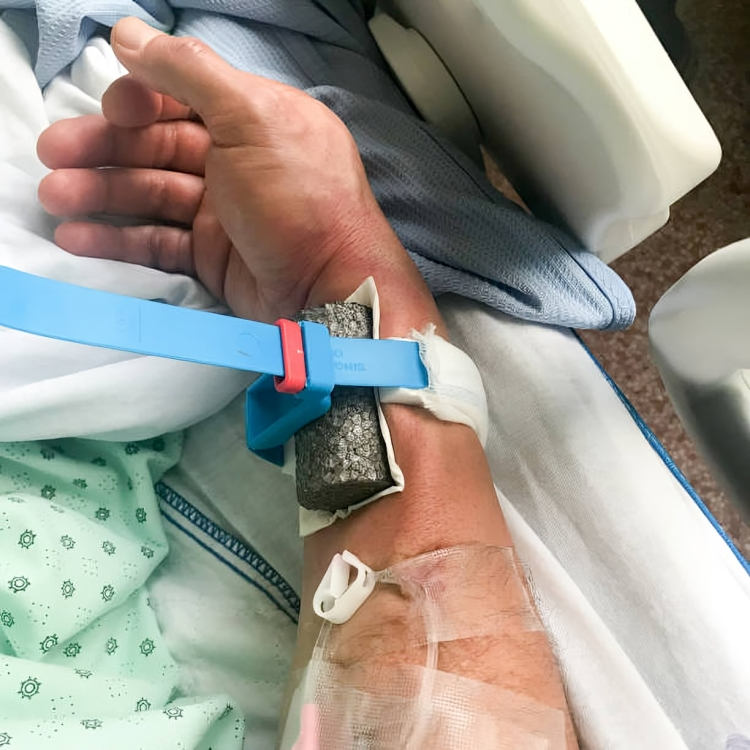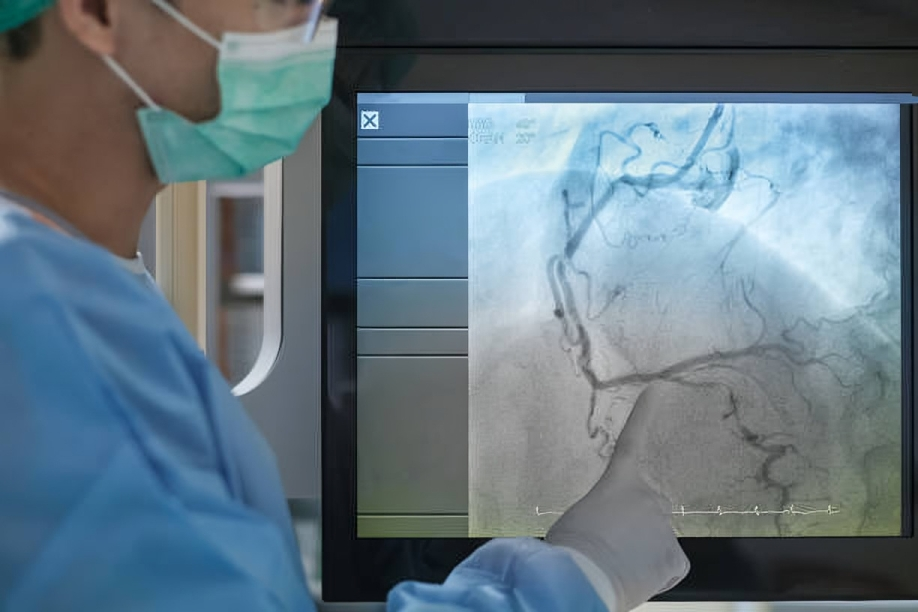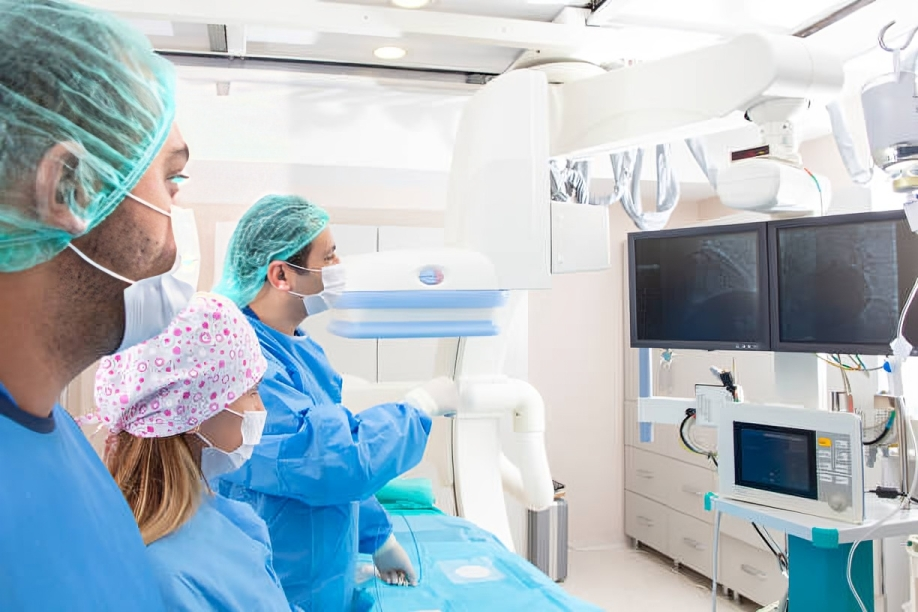A Coronary Angiogram is a diagnostic medical procedure that visualizes your heart’s inner vessels, called coronary arteries. It helps determine if there are any abnormalities in your heart’s blood supply.
What is a Coronary Angiogram?
A coronary angiogram or coronary angiography is the go-to test for diagnosing obstructive heart disease. Doctors perform it to check for any obstruction in the blood supply to your heart.
Cardiologists and interventional radiologists perform angiograms in a hospital setting. They insert a catheter (thin tube) into an artery in your wrist or groin. They carefully move that tube, pass it into your heart, and inject an X-ray dye. This X-ray dye travels to your heart and helps visualize the regions of blockades in its coronary arteries.
It is usually performed without general anesthesia, though you will be given medication to help you relax.1Omeh, D. J., & Shlofmitz, E. (2023, August 7). Angiography. Nih.gov; StatPearls Publishing. https://www.ncbi.nlm.nih.gov/books/NBK557477/
Coronary Angiogram Indications
A coronary angiogram is mainly performed to locate and assess any occlusions or narrowing in your coronary arteries. Plaques of fat, ballooning areas, vessel aneurysms, or a blood clot can cause this blockage. Abnormal structures of the heart also cause poor blood supply.
The effects of poor blood supply to the heart are felt through cardiac symptoms, such as:
- Chest pain
- Chest discomfort
- Fatigue
- Breathlessness
- Dizziness
- Fainting
- Palpitations
- Swelling in legs and feet
- Cold sweats2Cademartiri, F., Casolo, G., Clemente, A., Seitun, S., Mantini, C., Bossone, E., Saba, L., Sverzellati, N., Nistri, S., Punzo, B., Cavaliere, C., La Grutta, L., Gentile, G., & Maffei, E. (2021). Coronary CT angiography: a guide to examination, interpretation, and clinical indications. Expert Review of Cardiovascular Therapy, 19(5), 413–425. https://doi.org/10.1080/14779072.2021.1915132
Ischemic Heart Disease
Ischemic heart disease occurs when the blood supply to the heart becomes dangerously low. There are two main types: angina and heart attack. A coronary angiogram helps detect the exact cause of angina. The extent of ischemia helps doctors formulate an effective treatment plan.
Angiography can help locate the exact blockage and help doctors determine the next step in patient management before unstable angina becomes myocardial infarction.
Heart Failure
Heart failure refers to the heart’s inability to pump blood. It can be caused by a variety of factors. If the cause is narrowing or blockage of the arteries, a coronary angiogram can help doctors locate it.
Valvular Heart Disease
Valvular heart diseases include stenosis or regurgitation of the aortic, mitral, tricuspid, and pulmonary valves. An angiogram can help doctors identify and treat these issues in your valves.
Before Surgery
A coronary angiogram helps doctors assess the health of your heart vessels before high-risk surgeries, such as:
- Coronary bypass surgery
- Heart transplant
- Aneurysm (abnormal ballooning of artery) repair
- Valve repair
- Valve replacement
- Surgery for thoracic cancers3Ren, X., Liu, K., Zhang, H., Meng, Y., Li, H., Sun, X., Sun, H., Song, Y., Wang, L., Wang, W., Wang, C., Wang, Y., Hou, Z., Gao, Y., Yin, W., Zheng, Z., & Lu, B. (2021). Coronary Evaluation Before Heart Valvular Surgery by Using Coronary Computed Tomographic Angiography Versus Invasive Coronary Angiography. Journal of the American Heart Association. Cardiovascular and Cerebrovascular Disease, 10(15). https://doi.org/10.1161/jaha.120.019531
As a follow-up to Treatment
Angiography determines your next course of treatment. Once your doctor has started you on medication, placed a stent in a coronary artery, or performed a major surgery, they will perform angiography if needed. This will help them rule out any complications and ensure a good prognosis.

How to prepare for Coronary Angiogram
History & Examination
Your healthcare provider will conduct a detailed history and examination before your coronary angiogram. They will ask you about your current health conditions, previous medical history, and any procedures you have had.
The doctor will also ask you about the current cardiac symptoms you’re experiencing. They will inquire about the triggers that worsen your symptoms. In addition, they will ask you about some specific risk factors of coronary angiogram, such as:
- Smoking
- High blood pressure
- High cholesterol
- Family history of heart issues4Causes and Risk Factors. (2023, December 20). NHLBI, NIH. https://www.nhlbi.nih.gov/health/coronary-heart-disease/causes
A healthcare professional will also check your vitals, like temperature, blood pressure, and pulse rate. They will listen to your lung and heart sounds with a stethoscope. After that, your doctor will ask you to undergo a series of investigations to make sure you are medically fit for your coronary angiogram:
- Complete blood count
- Coagulation profile
- Lipid profile
- Blood chemistry
- Blood glucose levels
- Echocardiography
Informed Consent
Your doctor will counsel you about the coronary angiogram procedure. After telling you about the steps of the procedure and any associated risks, they will ask you to sign a document as proof of your informed consent.
What should you not do before an Angiogram?
A nurse or doctor will guide you about what to do before your procedure. They will ask you to arrange a ride home and counsel you about dietary and medication intake. However, they will ask you to avoid a few activities, such as:
- Don’t withhold any vital info from your doctor.
- Your doctor will ask you to fast for at least 6 hours before your angiogram, so don’t have a whole meal or drink before your procedure.
- If you need medication, take it with a small sip of water only. Don’t take contraindicated medications like Metformin.
- Don’t have a whole meal or drink.
- You can take a bath, but avoid applying lotions or deodorants afterward.
- Don’t shave the surgery site on your own.
- Ensure you’re not wearing any jewelry.
Step-by-step procedure for a Coronary Angiogram
A coronary angiogram is performed by highly trained doctors and healthcare professionals assisting them in a cath lab in a hospital setting.
Before Coronary Angiogram
After confirming your medical status, a nurse will give you a sterile gown. They will ask you to remove any accessories and go to the bathroom to empty your bladder.
Premedication for Coronary Angiogram
You are usually awake during the coronary angiogram. General anesthesia is only offered to children. Local anesthetic agents are applied to the site where the doctor will insert a catheter.
Doctors may give you sedative medication to calm you down. These include benzodiazepines like lorazepam or diazepam. To control your physical symptoms of anxiety, they may also provide you with beta-blockers.5Wieneke Vlastra, Ronak Delewi, Rohling, W. J., Wagenaar, T. C., Hirsch, A., Meesterman, M. G., Vis, M. M., Wykrzykowska, J. J., Koch, K. T., Winter, Baan, J., Piek, J. J., Sprangers, M. A. G., & Henriques, J. P. S. (2018). Premedication to reduce anxiety in patients undergoing coronary angiography and percutaneous coronary intervention. Open Heart, 5(2), e000833–e000833. https://doi.org/10.1136/openhrt-2018-000833
During Coronary Angiogram
During the procedure, you will be asked to lie on your back. You will have the chance to observe the procedure on a computer monitor. The significant steps of the angiogram include:
- Your wrist or groin will be sterilized.
- The doctor will numb the area with local anesthesia.
- The doctor will make a small cut through which they will pass an “introducer” tube. The catheter will be passed into your blood via this guiding tube.
- The tube will be guided into your heart.
- Once inside your heart, x-ray dye will be injected.
- After this, multiple X-ray images will be taken, showing the different parts of your blood vessels.
- Once the visualization is over, the catheter will be carefully removed. A cath lab team member will pressure the site to prevent bleeding and then place a bandage over the area.
After Coronary Angiogram
After your coronary angiogram procedure, you will be moved to a short-stay recovery area on a stretcher or wheelchair. You will be helped into bed and asked to lie comfortably. A healthcare professional will ask you to avoid moving the catheter insertion site.
Your vitals will be monitored for a few hours, and doctors will wait for the sedatives to wear off. After that, they will discharge you. It is a day procedure, and you are usually discharged on the same day. However, if you undergo angioplasty after angiogram, you may have to stay in the hospital for a few days.

Coronary Angiogram Aftercare
Once your procedure is over, avoid driving home because of the sedatives. You should take the rest of the day off and avoid going near fire or handling any machinery.
Moreover, you can remove the bandage on your catheter injection site after 24 hours and take a shower after removing it. However, you should avoid getting into any body of water (bathtubs, swimming pools, saunas) for at least three days to avoid the risk of infections.
Similarly, you should avoid using any perfume or lotion on the injection site. You should also avoid strenuous activities, exercise, and sex for at least three days after your procedure.
Finally, make sure you visit your doctor one week after the angiogram for your follow-up appointment.
CT Coronary Angiogram Results
Your doctor will contact you once your report is ready and formally discuss the findings with you. Normal findings indicate healthy blood vessels and heart structures. Many abnormal findings can be handled with medication and lifestyle changes. More severe narrowing or blockage requires procedures such as angioplasty or surgery.
Your doctors can also tell you about the procedure on the spot, as you are awake during an angiogram. This is because doctors get the patient’s consent to perform an angioplasty alongside angiography when they encounter a serious issue. This can prolong your stay in the hospital a little, but you will be able to avoid serious health issues.

Coronary Angiogram Risks & Complications
The most common side effect seen after a coronary angiogram is the formation of a hematoma. It is the collection of blood at the injection site, which resolves in a few days. In addition, when patients don’t disclose their allergies, they can go into anaphylactic shock.
The risk of a major complication occurring after a coronary angiogram is less than 1 in 1000 patients. Such significant complications include:
- Stroke (because of dislodged plaque)
- Myocardial infarction
- Arrhythmia
- Kidney injury
- Death6Al-Hijji, M. A., Lennon, R. J., Gulati, R., Abdallah El Sabbagh, Jae Yoon Park, Crusan, D., Kanwar, A., Atta Behfar, Lerman, A., Holmes, D. R., Bell, M., & Singh, M. (2019). Safety and Risk of Major Complications With Diagnostic Cardiac Catheterization. Circulation. Cardiovascular Interventions, 12(7). https://doi.org/10.1161/circinterventions.119.007791
Coronary Angiogram Contraindications
It is better not to perform a coronary angiogram in certain conditions. These include:
- Pregnancy
- Allergy to the dye used in an angiogram
- Kidney failure
- Iodine therapy
- Acute heart failure7Ramjattan, N. A., Lala, V., Kousa, O., Shams, P., & Makaryus, A. N. (2024, January 19). Coronary CT Angiography. Nih.gov; StatPearls Publishing. https://www.ncbi.nlm.nih.gov/books/NBK470279/
Coronary Angiogram Vs. Cardiac Catheterization
Cardiac catheterization refers to a wide number of medical procedures that involve inserting a catheter into the heart. It can be both diagnostic and therapeutic. Comparatively, a coronary angiogram is a specific type of cardiac catheterization used to visualize coronary arteries. It is diagnostic.
What is the success rate of an Angiogram?
According to research, coronary angiogram boasts over 95% success rate. This includes both diagnostic coronary angiograms and therapeutic angioplasty, which follow when doctors find an abnormality.8Sondagur AR;Wang H;Cao Y;Lin S;Li X. (2014). Success rate and safety of coronary angiography and angioplasty via radial artery approach among a Chinese population. The Journal of Invasive Cardiology, 26(6). https://pubmed.ncbi.nlm.nih.gov/24907084/
Is Angiography Painful?
While catheter insertion may cause some discomfort, a coronary angiogram is not a painful procedure. Moreover, the doctors apply local anesthesia to the insertion site, and any pain should immediately be reported to the team performing the angiography.
What is the maximum age for Angiography?
There is no age limit for angiography. However, it is not suitable in very old age, as blood vessels lose their elasticity and become delicate. In such elderly populations, the risks outweigh the benefits, and other forms of imaging are suitable.
How much rest is required after Angiography?
The doctors advise resting for at least a day after the angiography procedure. You should avoid any taxing activities and wait until the morning after to return to work and chores. However, it is important to let the sedative medications administered during the angiogram wear off and make sure that the bandage is not taken off for at least a day.
Conclusion
To conclude, A coronary angiogram is a common medical procedure used to assess the blood supply to the heart. It identifies if there is a narrowing or blockage of the coronary arteries or their neighboring structures. It is a safe outpatient procedure performed without anesthesia. Patients are discharged the same day and can return to normal life soon after.
Refrences
- 1Omeh, D. J., & Shlofmitz, E. (2023, August 7). Angiography. Nih.gov; StatPearls Publishing. https://www.ncbi.nlm.nih.gov/books/NBK557477/
- 2Cademartiri, F., Casolo, G., Clemente, A., Seitun, S., Mantini, C., Bossone, E., Saba, L., Sverzellati, N., Nistri, S., Punzo, B., Cavaliere, C., La Grutta, L., Gentile, G., & Maffei, E. (2021). Coronary CT angiography: a guide to examination, interpretation, and clinical indications. Expert Review of Cardiovascular Therapy, 19(5), 413–425. https://doi.org/10.1080/14779072.2021.1915132
- 3Ren, X., Liu, K., Zhang, H., Meng, Y., Li, H., Sun, X., Sun, H., Song, Y., Wang, L., Wang, W., Wang, C., Wang, Y., Hou, Z., Gao, Y., Yin, W., Zheng, Z., & Lu, B. (2021). Coronary Evaluation Before Heart Valvular Surgery by Using Coronary Computed Tomographic Angiography Versus Invasive Coronary Angiography. Journal of the American Heart Association. Cardiovascular and Cerebrovascular Disease, 10(15). https://doi.org/10.1161/jaha.120.019531
- 4Causes and Risk Factors. (2023, December 20). NHLBI, NIH. https://www.nhlbi.nih.gov/health/coronary-heart-disease/causes
- 5Wieneke Vlastra, Ronak Delewi, Rohling, W. J., Wagenaar, T. C., Hirsch, A., Meesterman, M. G., Vis, M. M., Wykrzykowska, J. J., Koch, K. T., Winter, Baan, J., Piek, J. J., Sprangers, M. A. G., & Henriques, J. P. S. (2018). Premedication to reduce anxiety in patients undergoing coronary angiography and percutaneous coronary intervention. Open Heart, 5(2), e000833–e000833. https://doi.org/10.1136/openhrt-2018-000833
- 6Al-Hijji, M. A., Lennon, R. J., Gulati, R., Abdallah El Sabbagh, Jae Yoon Park, Crusan, D., Kanwar, A., Atta Behfar, Lerman, A., Holmes, D. R., Bell, M., & Singh, M. (2019). Safety and Risk of Major Complications With Diagnostic Cardiac Catheterization. Circulation. Cardiovascular Interventions, 12(7). https://doi.org/10.1161/circinterventions.119.007791
- 7Ramjattan, N. A., Lala, V., Kousa, O., Shams, P., & Makaryus, A. N. (2024, January 19). Coronary CT Angiography. Nih.gov; StatPearls Publishing. https://www.ncbi.nlm.nih.gov/books/NBK470279/
- 8Sondagur AR;Wang H;Cao Y;Lin S;Li X. (2014). Success rate and safety of coronary angiography and angioplasty via radial artery approach among a Chinese population. The Journal of Invasive Cardiology, 26(6). https://pubmed.ncbi.nlm.nih.gov/24907084/





